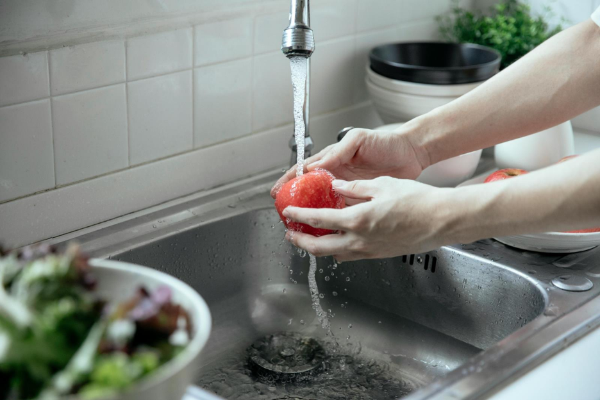
Food Safety 101: How To Keep Your Food Safe And Your Family Healthy
August 6, 2025 - Gary Libretti
Food safety practices are essential for preventing foodborne illnesses, which can cause anything from mild stomach upset to serious health complications. Fortunately, practicing a few simple habits can go a long way in keeping your food safe.
1. Clean: Wash Hands and Surfaces Often
- Wash your hands with soap and water for at least 20 seconds before and after handling food. Click here for a handwashing tutorial.
- Clean cutting boards, utensils, and countertops with hot, soapy water.
- Rinse fruits and vegetables under running water, even if you plan to peel them.
- Click to read more information on Enjoying Produce Safely.
2. Separate: Avoid Cross-Contamination
- Keep raw meat, poultry, seafood, and eggs separate from ready-to-eat foods.
- Use separate cutting boards, when possible, for raw meat and other items like vegetables and bread. If the same cutting board is used, thoroughly wash between uses.
- Store raw meats sealed and on the bottom shelf of the fridge to prevent juices from dripping onto other foods.
- If meat is frozen, it can be thawed in the following ways:
- In the refrigerator, in a sealed container. May take 24 hours (best method)
- Submerged under cold water and sealed in a leak-proof container. Change the water every 30 –minutes. May take 1- 6 hours. Cook immediately after thawing.
- In the microwave using the defrost setting or 30-50% power. Cook immediately after thawing.
- Never thaw meat on the counter, under hot water, or outdoors.
- Click here to read more about Thawing Foods Safely.
- Organize the refrigerator: based on temperature requirements, accessibility, and overall safety. Note the warmest part of the refrigerator should be at 40 degrees or lower.
- Top shelves: are warmer than bottom shelves and are best for ready-to-eat items, leftovers, and don’t require cooking.
- Middle shelves: should have a consistent temperature and suitable for storage of items such as dairy products, eggs, and spreads.
- Bottom shelves: are the coldest and ideal for meat, poultry, and seafood. Note, these items should be kept separate and sealed in storage to prevent any drip or leakage. Drawers can also be used to store meat, poultry, and fish items, but should not be mixed with other items.
- Drawers: are designed for fruits and vegetables with the ability to control humidity.
- Low-humidity drawers: keep the drawer vent open to allow for airflow and moisture to escape. Fruits such as apples, melons, and avocados, as well as vegetables like mushrooms, should be kept in a lower humidity drawer.
- High-humidity drawers: keep the vent closed to restrict airflow and increase moisture. Thin-skinned or leafy vegetables and herbs that are prone to wilting or losing their moisture, are ideal for a higher humidity drawer. This includes lettuce, spinach, broccoli, cucumbers, carrots, as well as fruits such as strawberries.
- First in, first out: place newer items behind older items to ensure the older items are used first.
- Regular cleaning: The refrigerator requires routine cleaning by wiping down shelves and drawers with hot soapy water to prevent bacteria growth.
3. Cook: Heat Food to the Right Temperature
- Use a food thermometer to ensure food is cooked thoroughly. Insert the thermometer into the thickest part of the item. Thoroughly wash the thermometer after each use to prevent cross-
- Click here for more on using a food thermometer.
- Minimum cooking temperatures:
- Poultry: 165°F (74°C)
- Ground meats: 160°F (71°C)
- Seafood: 145°F (63°C)
- Eggs: 160°F (71°C) when egg white and yolk are firm
- Click for more information on safe cooking temperatures.
- Reheat leftovers to at least 165°F (74°C) before eating.
4. Chill: Refrigerate Promptly
- Keep the fridge at 40°F (4°C) or below.
- Refrigerate leftovers within 2 hours of cooking (1 hour if the air temperature is above 90°F/32°C).
- Thaw food in the refrigerator, not on the counter. See the above section for ways to properly thaw frozen meat.
- Click here for more safety tips on Keeping Foods Out of the Temperature Danger Zone and Handling Leftovers Safely.
5. Know When to Toss It
- To minimize food waste and keep you safe, check food product dates and look for signs of spoilage (like a sour smell or mold). Click here to read more on food product dates.
- When in doubt, throw it out. It’s better to be safe than sick.
Final Tips
- Don’t rely on taste or smell to judge if food is safe to eat—you can’t see, smell, or taste harmful pathogens that can make us sick.
- Stay informed about food recalls and follow guidance from health authorities.
By following 4 Steps to Food Safety—clean, separate, cook, chill—you’ll greatly reduce the risk of foodborne illness and keep your meals safe and healthy.
Stay safe, eat smart!



 Print
Print Email
Email



